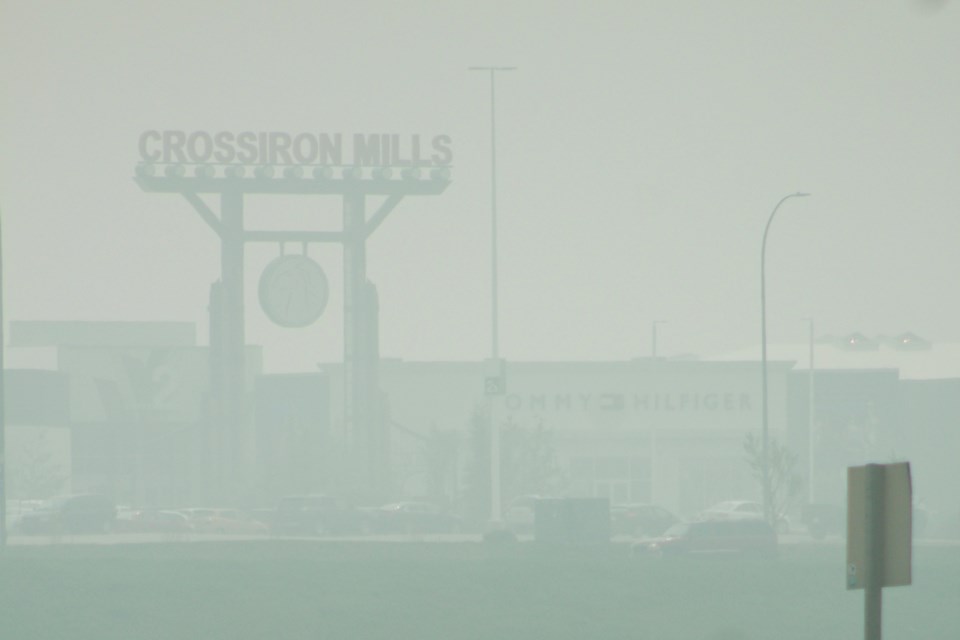Airdrie and the surrounding region bid farewell to May under a blanket of smoke, prompting air quality advisories.
According to Kyle Fougere, meteorologist with Environment and Climate Change Canada, smoky conditions in the region May 31 were a result of smoke generated by forest fires in northern Alberta being driven south due to a cold front sweeping over the province May 30.
“The northerly winds behind the cold front brought that smoke down all the way across Southern Alberta and into the northern states,” he said. “That smoke has continued on and has now reached the United Kingdom [as of June 4].”
The smoky conditions caused reduced visibility and drove the local Air Quality Health Index (AQHI) into the high-risk zone, leading Environment Canada to issue an air quality advisory.
The AQHI, Fougere explained, is a scale from one to 10 that measures local air quality by looking at three pollutants – nitrogen dioxide, ozone and particulate matter 2.5 microns in size – and indicates the risk level associated with the air quality. The AQHI indicates current air quality, and also forecasts future air quality for the day, he said. Airdrie’s AQHI can be found at weather.gc.ca/airquality/pages/abaq-014_e.html
Dr. David Strong, lead medical health officer for Alberta Health Services Calgary Zone, said the main concern on smoky days comes from particulate matter in the air, which can enter deep into the lungs and even the bloodstream, adversely impacting young children, seniors and individuals with chronic lung or heart conditions.
Particles are an irritant, he said, and cause inflammation in the airways, resulting in coughing. Strong said other short-term risks include dry eyes and exacerbation of preexisting conditions such as asthma.
“The build-up of secretions in the airways can also impact people with cardiovascular conditions,” he said. “It’s people who are vulnerable that are most at risk, and that’s why the AQHI is very helpful to not only provide information about quality of the air, but also the expected health impacts.”
Strong said there is currently no strong evidence about the long-term effects of prolonged wildfire smoke exposure.
According to Fougere, the winds in most of the province changed direction quickly May 31, blowing the smoke away and clearing conditions by the weekend.
“The thing is that the extreme weather conditions have remained, so we have seen a lot of smoke continuously being produced by these fire,” he said. “It’s looking like, [over the June 8] weekend, we’re finally going to see some fairly widespread rain that will hopefully improve conditions in the north.”
Fougere added June tends to be one of the wettest months of the year, which will help remove smoke particles from the air and tamp down wildfires.
While Fougere said it’s unlikely the area will see smoky conditions again in the immediate future, there is a high likelihood of poor air quality later in the summer. It’s not uncommon to see wildfires generate smoke in northern Alberta during May due to dry conditions, he said, and similarly, dry conditions in August tend to result in fires in British Columbia and western Alberta. Throughout the past few years, Alberta has seen increasingly smoky summers, and that could become the new normal, he said.
“We have been seeing hotter and drier summers,” he said. “You can’t link one individual event to climate change, but as our climate changes, we do expect to see hotter summer on the prairies, and we do expect to see a slight decrease in precipitation. And climate change is expected to bring an increased frequency of extreme fire weather.”
When smoky days occur, Strong said, the best path is avoidance. Residents should avoid strenuous outdoor activity that results in heavy breathing when the AQHI drifts into the high-risk zone, and it’s advisable to stay indoors with windows closed, he said. To avoid the heat, families should consider the use of air conditioning units, or pass the time at air-conditioned public facilities like malls, movie theaters or recreation centres.
In addition to monitoring the AQHI, Strong suggested individuals concerned about the impacts of smoke should consult their physician, or call Health Link at 811.



